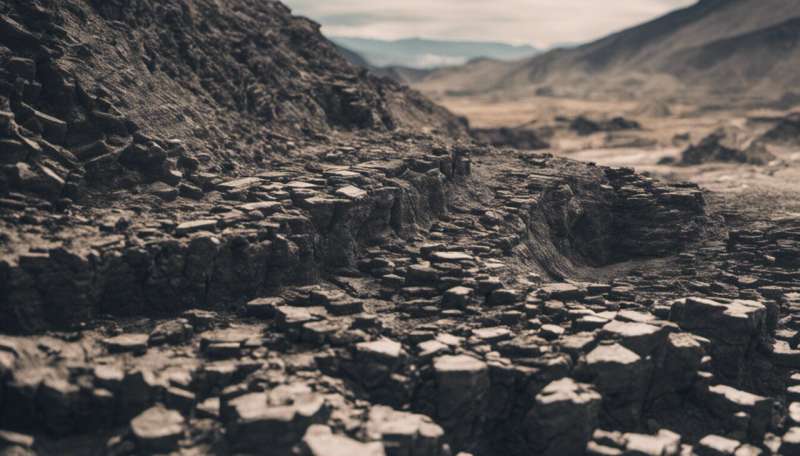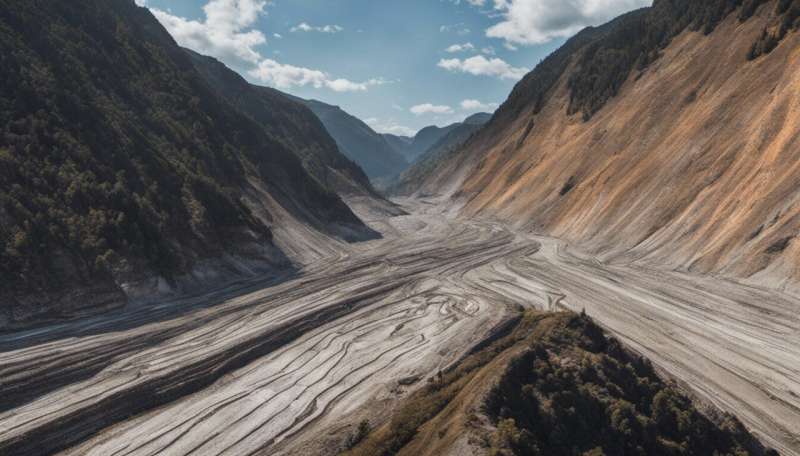This article has been reviewed according to Science X's editorial process and policies. Editors have highlighted the following attributes while ensuring the content's credibility:
fact-checked
trusted source
proofread
Geotechnical expert says one in four international tailings dam failures are due to earthquakes

Did you know the U.S. National Earthquake Information Center logs the measurements of 20,000 earthquakes around the globe each year—approximately 55 a day?
A concern that most people might not immediately consider is the impact on tailings dams, which are some of the largest engineered structures on earth, designed to store the by-products of mining operations.
About once every six months, Australia is impacted by an earthquake exceeding magnitude five or greater—which is sufficient to cause extensive damage to a tailings dam.
"Australia's earthquakes are intraplate, meaning they occur at locations away from continental plate margins such as the earthquakes that occur in Japan and California," says Adrian Russell, a Professor in Geotechnical Engineering and an Australian Research Council Future Fellow at UNSW's School of Civil and Environmental Engineering.
Just last month, parts of South Australia were rocked by the largest earthquake the state has experienced in nine years when a 4.8 magnitude quake was recorded in the Flinders region. In 2021, Melbourne was shaken by an earthquake in Port Phillip Bay, with aftershocks felt as far away as Sydney.
Tailings dams may be at risk of failure
When an earthquake occurs, the risk to tailings storage facilities (TSF), often referred to as tailings dams, may not be front of mind.
Tailings dams are embankment dams, sometimes kilometers in length, constructed to contain and store tailings, which are by-products of mining operations after processing the mined ore. The tailings contained behind the embankments usually consist of ground rock, metals and even toxic and radioactive chemicals.
Prof. Russell says unfortunately, 25% of global tailings dam failures are due to an earthquake.
"One of the major priorities of the minerals extraction and mining industries is to reduce the numbers of catastrophic failures of tailings dams," he says.
"When tailings dam fails, it's catastrophic. The amount of damage it can cause to the environment is unthinkable—not to mention the risk it poses to any civilians.
"These structures can be huge, with embankments sometimes reaching 300 meters in height, so you can imagine the amount of tailings stored behind them.
"And they need regular maintenance and monitoring to ensure that the embankment is strong enough to contain the tailings.
"Shaking an already marginally stable embankment may cause a failure and sudden release of the tailings."
Impact of a tailings dam failure
In Australia alone, there are around 250 active tailings dams. Considering the mining sector is one of Australia's biggest industries, the performance of these dams is imperative to the safety of the operation, the civilians working on those mines, and the surrounding environment and communities.
"There are a wide range of impacts of a TSF failure. When some TSFs fail, luckily there is minimal damage," says Prof. Russell.
"In 2018, there was a TSF failure at the Cadia gold mine in New South Wales. The slumped section of the embankment and tailings did not travel far enough to cause environmental damage or fatalities."
But failings can also result in a huge discharge of tailings into the natural environment, possibly resulting in fatalities and serious economic loss.
For example, in 2019 the catastrophic failure of a tailings dam at Brumadinho in Brazil killed 270 people and the resulting water pollution in the Paraopeba river impacted communities up to 120 kilometers away.

"If a TSF failure has the potential for high or extreme consequences then the TSF owners are mandated by dam authorities in their respective countries to conduct thorough stability assessments every two years," Prof. Russell says.
"These standards and regular testing are important if we want to avoid a catastrophic failure such as the Brumadinho dam disaster in Brazil in 2019."
Measuring the risk of a potential failure
In Australia, one of the ways to assess the dams and the tailings they contain is through cone penetration testing (CPT). The CPT enables geotechnical engineers to determine their properties and asses their strength and stability.
The test usually involves pushing a cone tipped rod vertically into the embankment or tailings at a constant rate of penetration. During this process, measurements are made to collect data of the cone tip resistance.
Previous research from Prof. Russell and his team have empowered engineers to interpret CPT results in tailings when they have varying states, including when they have a mixture of air and water in the pores, or, in other words, when they are unsaturated.
The findings from that study demonstrated how to use CPT results to determine the in-situ state of the tailings—which is extremely important as it controls how strong and earthquake-resistant the tailings will be.
"Prior to this research, engineers routinely and incorrectly interpreted the CPT results by assuming the tailings are fully saturated, which isn't always the case," says Prof. Russell.
"This led to incorrect determinations of in-situ state of the tailings and overestimations of strength."
In his latest research paper, published in Géotechnique, Prof. Russell and his team have shown practitioners how to estimate the post-earthquake strength of a tailings when unsaturated.
"The CPT interpretation methods and strength assessments used in industry prior to these discoveries were developed primarily for saturated natural soils," says Prof. Russell.
"There are many differences between saturated natural soils and tailings in a dam, with tailings being siltier, or more dust-like, and unsaturated in many cases.
"This rectifies what many falsely assume: that unsaturated tailings do not liquefy in an earthquake. This means engineers can use improved strength estimations in any earthquake stability assessment to accurately identify which TSFs are more at risk of failure."
Looking ahead
The Australian National Committee on Large Dams (ANCOLD) underscores the risks of TSF failures in Australia. It requires all high-consequence category TSFs to remain safe even after they're closed, and able to withstand a one-in-10,000-years earthquake.
Prof. Russell says it's not just tailings dams that may become damaged. Reinsurance companies rate an earthquake in Sydney within their 20 top risk exposures worldwide.
"Australian cities are at a high risk as an earthquake would compromise old infrastructure made of unreinforced brick and masonry," he says.
"Also, large areas in Australian cities are underlain by soils which may experience strength loss and turn to a fluid-like state, or liquefaction, in the event of an earthquake.
"An area of particularly high risk is Botany Bay where major ports are located. If an earthquake caused liquefaction of the ground around Botany Bay widespread damage could result, with infrastructure becoming irreparable.
"Furthermore, the land may become uninsurable. The next generation of earthquake standards needs to move towards performance-based designs not only to protect life but also to reduce the significant economic losses resulting from direct damage and business interruption."
More information: Yanzhi Wang et al, Modelling unsaturated silty tailings and the conditions required for static liquefaction, Géotechnique (2023). DOI: 10.1680/jgeot.22.00074
Provided by University of New South Wales





















